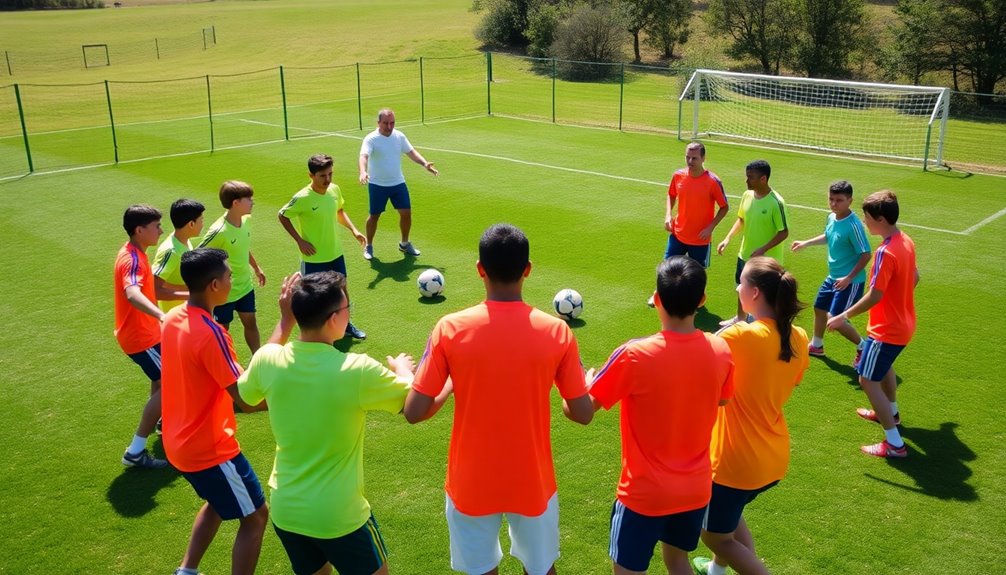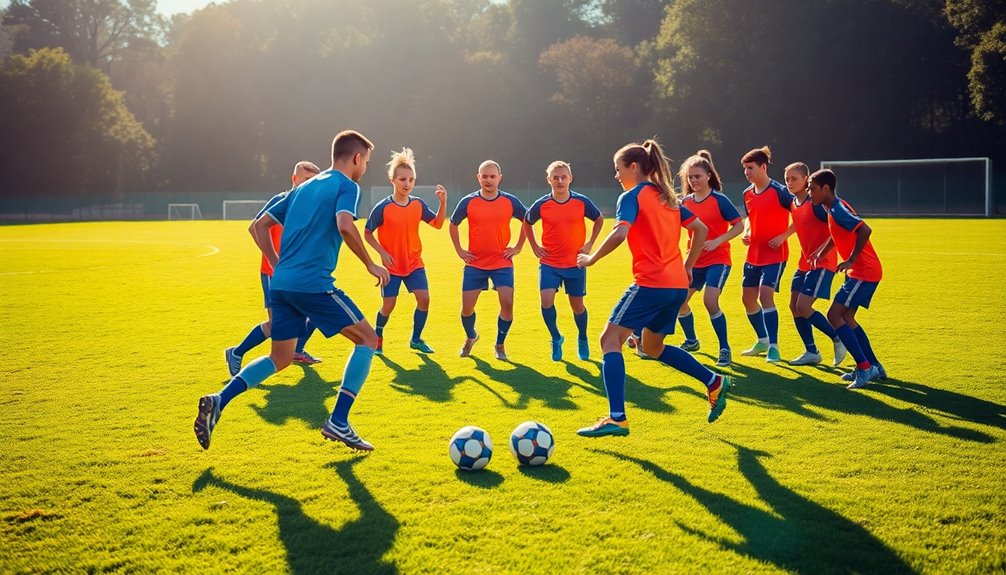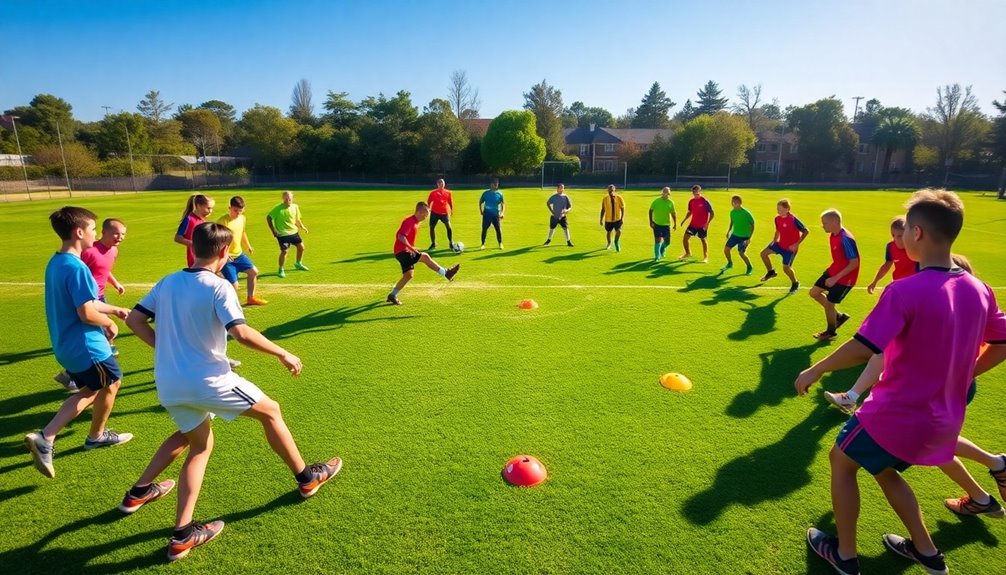
How to Use Rondo Soccer to Enhance Team Possession Skills
March 12, 2025To enhance your team's possession skills using rondos, set up small-sided passing drills focusing on quick, precise passes under pressure. Involve all players to boost communication and decision-making. Use variations, like touch restrictions and different shapes, to challenge players and improve their tactical awareness. Regularly rotate positions to develop versatility and adapt to game scenarios. With consistent practice, you'll notice significant improvements in teamwork and ball control, and there's more to discover about maximizing these drills.
Understanding Soccer Rondos
When you step onto the training field, understanding soccer rondos can greatly enhance your skills.
These small-sided passing drills create a fast-paced environment for players to develop vital decision-making skills and ball control under pressure. Rondos, like 3v1 or 4v2 formats, simulate real-game scenarios, allowing you to practice maintaining possession against defenders. Engaging in these drills also helps improve passing accuracy, which is crucial for effective gameplay. Additionally, consistent practice through daily drills can significantly boost your technical abilities and muscle memory.
This competitive atmosphere fosters teamwork and communication, essential for successful team possession. By engaging in these training sessions, you'll refine your passing accuracy and speed while working closely with teammates.
As you cycle through the rondo, you'll learn to recognize patterns and make quick decisions, ultimately improving your overall game. Embrace the challenge of soccer rondos to elevate your skills and enhance your performance. Incorporating teamwork enhancement exercises can further solidify your understanding of possession play and improve overall effectiveness on the field.
Benefits of Incorporating Rondos in Training
Incorporating rondos in your training can transform your soccer skills by greatly enhancing your passing accuracy and speed. As you engage in these drills, you'll find it easier to maintain possession even under pressure from defenders. Additionally, mastering close marking within rondos can further enhance your ability to evade defenders during matches. Practicing effective footwork drills during rondos will also help you improve your dribbling speed and precision.
Rondos also improve communication and coordination among players, fostering a better understanding of spatial awareness and movement off the ball. You'll learn to make quick decisions as you evaluate passing options, sharpening your decision-making skills. Regular practice builds your confidence, allowing you to replicate successful possession strategies in matches.
Additionally, the fast-paced nature of rondos promotes a high number of ball touches, essential for developing both individual and team technical skills. Incorporating cardio training methods into your routine can further enhance your stamina, ensuring you can perform at your best during intense rondo sessions. Embrace rondos to elevate your game!
Setting Up a Rondo Drill

Setting up a rondo drill is straightforward and rewarding. Start by gathering five to ten players and begin with a smaller playing area. Arrange the players in a circle, placing one or two defenders in the center. This creates a dynamic keep-away scenario that emphasizes quick passing and movement.
To enhance skills, implement variations like one-touch passing or touch limits, ensuring players stay focused. Incorporating agility drills can further challenge players and develop their ability to maneuver under pressure. This type of drill also fosters team coordination, as synchronized movements are essential for effective play. Tailor the rondo setup to match your team's skill level, adjusting complexity as needed.
You can also use different shapes—circle, triangle, or square—to target specific skills like ball control, communication, and spatial awareness. This effective setup helps improve your team's possession skills in an engaging way. Additionally, incorporating skills like the Elastico technique can further challenge players and develop their ability to maneuver under pressure.
Types of Rondos to Enhance Skills
To enhance your team's skills effectively, exploring various types of rondos can make a significant difference.
Start with a circle rondo, where players practice quick passing and ball control under pressure.
Next, try a triangle rondo to improve communication and movement off the ball, fostering spatial awareness.
A square rondo encourages players to enhance decision-making skills by finding passing options in tight spaces.
For tailored skill development, implement role-specific rondos that focus on the unique needs of positions like fullbacks or midfielders.
Finally, larger rondos, such as 7v2 formats, simulate tactical formations, promoting teamwork and adaptability. Effective communication among players during these drills can further enhance their ability to maintain possession.
Each type of rondo plays an essential role in helping players maintain possession and improve overall game performance.
Essential Coaching Tips for Effective Rondos

Rondos aren't just about the drills; they require effective coaching to maximize their benefits.
To help players practice passing and receiving, maintain an open body position so they can quickly assess options. Implement touch restrictions, like limiting touches to one or two, to enhance accuracy and speed up decision-making under pressure. This approach mirrors the importance of tactical considerations in formation selection, emphasizing the need for disciplined movement. Additionally, incorporating dynamic warm-up routines can prepare players physically for the demands of rondos.
Vary rondo formats, such as 4v2 or 5v2, to challenge players' ability to keep possession against different numbers of defenders. Encourage continuous movement and communication to create passing lanes and support angles, fostering a strong team dynamic.
Regularly rotate players in their roles to develop versatility, ensuring everyone experiences both attacking and defensive responsibilities during your training sessions. Incorporate agility and coordination drills alongside rondos to further improve players' ability to navigate tight spaces and evade defenders effectively.
Role-Specific Rondos for Targeted Practice
To maximize your training, try incorporating role-specific rondos into your routine.
For fullbacks, focus on passing drills that sharpen your defensive decision-making, while midfielders can work on quick thinking and ball control. Engaging in defensive stance drills can significantly improve your fullbacks' ability to maintain their positioning during these exercises.
Strikers should tackle finishing scenarios to enhance their scoring instincts and movement off the ball. Additionally, integrating these drills with a focus on essential soccer skills can further improve overall team performance and cohesion.
Fullback Passing Drills
Fullback passing drills are essential for honing the skills needed to thrive in dynamic game situations.
These rondos focus on enhancing your passing ability and decision-making under pressure, simulating real match scenarios. In a typical 4v2 format, you'll practice maintaining possession, making overlapping runs, and delivering precise crosses into attacking areas.
Incorporating variations like the Triangle Rondo emphasizes the importance of communication and movement off the ball, ensuring you're always available for a pass.
Regularly engaging in these drills boosts your spatial awareness and builds confidence in executing accurate passes and defensive shifts.
Midfielder Decision-Making Exercises
While you practice midfielder decision-making exercises, you'll find that these role-specific rondos are essential for developing your ability to thrive in tight game situations.
In a typical 4v2 or 5v2 format, you'll focus on maintaining possession while executing quick passes and understanding positioning. Incorporating specific passing patterns, like one-touch or two-touch play, pushes you to think quickly and adapt to dynamic game scenarios.
Communication is key—coordinating movements with your teammates creates passing opportunities and helps keep possession under pressure.
Regularly engaging in these rondos will boost your confidence, enhancing your decision-making skills and overall performance.
As you improve, you'll notice a significant impact on your ability to navigate real-game challenges effectively.
Striker Finishing Scenarios
Building on the skills developed through midfielder decision-making exercises, strikers can enhance their finishing abilities with targeted rondo drills.
Focus on tight space scenarios that simulate game situations, helping you receive and finish under defensive pressure. Incorporate drills requiring a set number of passes before shooting to improve teamwork and ball retention.
These rondo drills can include defenders, pushing you to practice quick decision-making and finishing in contested situations. Vary the drills by limiting touches or specifying pass types to develop adaptability and creativity in your attacking play.
Creative Variations to Keep Drills Engaging

To keep your rondo drills engaging, you can easily introduce creative variations that challenge players and enhance their skills. Incorporate specific passing patterns, like one-touch limits, to improve decision-making and passing accuracy.
Add a competitive aspect by introducing a scoring system where teams earn points for completing passes or executing penetrating passes. Try variations like "Escape the Rondo," emphasizing quick changes and reaction speed.
Utilize different shapes, such as triangles or squares, to boost communication and spatial awareness while keeping drills fresh.
Finally, implement a Rondo Pressure Drill, where teams compete to complete the most consecutive passes under dynamic conditions, fostering teamwork and communication.
These engaging drills will keep players motivated and continuously developing their skills.
Rondo Drills for Different Skill Levels
When it comes to rondo drills, beginners can start with simple variations like 3v1 setups to build confidence and basic skills.
As players advance, you can introduce more complex techniques, such as 5v2 drills, to challenge their decision-making and teamwork.
Tailoring these drills to skill levels keeps training effective and engaging for everyone involved.
Beginner Rondo Variations
Beginner rondo variations are a fantastic way to introduce players to the fundamentals of passing and receiving. Typically structured as 3v1 or 4v1 drills, these formats allow players to focus on basic techniques without overwhelming pressure.
To enhance skills, coaches can incorporate touch restrictions, limiting players to one or two touches, which improves first touch and passing accuracy. Using smaller playing areas encourages quick decision-making and helps players maintain possession under pressure.
Adding specific goals, like completing a certain number of passes before switching roles, fosters a sense of competition and engagement. As players progress, coaches can gradually increase complexity by introducing different shapes, like triangular or square formations, to challenge their developing skills.
Advanced Rondo Techniques
While mastering the basics of rondo is essential, advancing your skills requires exploring more complex techniques that challenge your abilities and decision-making.
Advanced rondo techniques, like the Rondo Pressure Drill, push you to communicate and work as a team under dynamic conditions. For higher skill levels, the Rondo To Attack drill emphasizes possession of the ball by setting a specific number of passes before attempting to score.
Additionally, role-specific rondos tailor practices to your position, enhancing tactical awareness. Larger formats, such as the 9v4 rondo, improve spatial awareness and quick decision-making.
Regularly changing variables, like touch limits or playing area size, keeps advanced players engaged and promotes continuous skill development in these training drills.
Analyzing Team Performance With Rondos

Analyzing team performance with rondos provides valuable insights into players' abilities in a controlled setting, allowing you to assess critical aspects like passing accuracy and decision-making speed.
By monitoring how well your team maintains possession during rondo drills, you can identify areas for improvement in communication and movement off the ball.
Utilizing specific rondo formats, such as 5v2 or 4v2, gives you quantifiable data on how effectively your team operates with a numerical advantage and simulates match scenarios.
You can evaluate individual contributions by tracking successful passes, interceptions, and adaptability under pressure.
Regular analysis of rondo performance leads to tailored training interventions that address weaknesses, ultimately enhancing the overall team performance in competitive matches.
Integrating Rondos Into Game Strategies
Integrating rondos into your training not only simulates game situations but also sharpens your tactical awareness.
By practicing quick passing and movement under pressure, you'll learn how to maintain possession in various formations.
This focused approach helps you grasp your positional responsibilities, making you more effective during real matches.
Game Situation Simulations
As you incorporate rondos into your training sessions, you'll find they effectively simulate real-game situations, helping players maintain possession under pressure.
These scenarios enhance decision-making and build skills vital for match success. Here are three key benefits of using rondos for game situation simulations:
- Realism: Players practice maintaining possession while facing pressure, just like in actual matches.
- Adaptability: With variations in passing patterns, players learn to navigate tight spaces, preparing them for complex game situations.
- Team Cohesion: Regular rondo drills develop a collective understanding of spacing and support, essential for attacking players to shift effectively.
Tactical Awareness Development
Tactical awareness is essential for any soccer player aiming to excel on the field, and incorporating rondos into your training is a powerful way to enhance this skill.
Rondos simulate game-like pressure, pushing players to make quick decisions in tight spaces. By practicing various formations—like circles, triangles, or squares—you'll deepen your spatial understanding and learn to exploit passing lanes.
Role-specific rondos allow you to hone your tactical responsibilities, promoting better decision-making. Regularly integrating rondos with small-sided games reinforces your ability to apply these skills in real scenarios, ultimately improving team cohesion and possession.
As you sharpen your tactical awareness, you'll become a more effective player, better equipped to read the game and contribute to your team's overall strategy.
Conclusion
Incorporating rondos into your training can transform your team's possession skills like magic. By understanding and practicing these drills, you'll see improvements in quick decision-making, teamwork, and ball control. Remember to get creative with variations to keep players engaged and excited. As you analyze your team's performance, you'll discover how rondos can seamlessly integrate into your overall game strategy, turning your squad into a possession powerhouse on the pitch. Keep practicing, and watch your skills soar!


